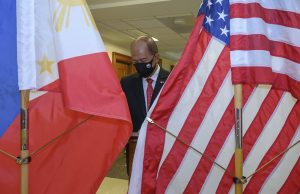Last week, the defense chiefs of the United States and the Philippines met in Washington, D.C. in the latest high-level consultation between the two treaty allies since U.S. President Joe Biden took office earlier this year. While the talks were part of a process of ongoing interactions, they also signaled efforts to chart out new agenda items for the U.S.-Philippine alliance that bear watching for both countries and the region more generally in the context of lingering challenges for both sides.
The U.S.-Philippine alliance – enshrined in the 1951 U.S.-Philippine Mutual Defense Treaty and part of a wide range of U.S. engagements with the Philippine people and a long history dating back to U.S. conquest of the Philippines in 1898 – has remained a key piece of U.S. defense engagement in the Asia-Pacific, despite facing its share of ups and downs over the decades. The rise of Philippine President Rodrigo Duterte had seen an uptick in friction between the two allies, with Duterte reversing Philippine positions on issues such as the South China Sea, strengthening ties with China and Russia and threatening to nix areas of cooperation, including the Visiting Forces Agreement (VFA).
U.S. President Joe Biden’s entry into office presented an opportunity for both sides to recalibrate their relationship, including in the area of defense. While consultations on this score have been ongoing since the administration took office, signs of renewed optimism entered the public sphere during U.S. Defense Secretary Lloyd Austin’s trip to the Philippines in July, during which both sides agreed to a restoration of the VFA.
Last week, the U.S.-Philippine defense relationship was in the spotlight again with a meeting between Austin and Defense Secretary Delfin Lorenzana. The talks took place as part of a series of consultations between Washington and a visiting Philippine delegation led by Lorenzana and Philippine Foreign Secretary Teodoro Locsin, which officials indicated included engagements with U.S. agencies including the White House, State Department, and Pentagon, as well as segments of the think tank, business, and Philippine-American communities.
Unsurprisingly, not much in the way of specifics was publicly disclosed by either side. Yet a readout of the meeting between the two noted that both sides had agreed to undertaken “a number of new initiatives” to ensure the alliance “is postured to address new and emerging challenges.” These included developing a joint vision statement, concluding a bilateral maritime framework, reconvening a Bilateral Strategic Dialogue (BSD) and resuming projects under the Enhanced Defense Cooperation Agreement (EDCA). While these are far from surprising individual initiatives, taken collectively, they hold significance in that they suggest an effort to outline an agenda to modernize the alliance amid new challenges.
The references to a joint vision statement and a bilateral maritime framework both point to new areas of collaboration within the alliance, even though no further specifics were publicly disclosed. If reached, a U.S.-Philippine joint vision statement of some kind would provide an opportunity for both sides to align broadly on priority areas of collaboration, as Washington has done in the past with other Asian allies and partners, such as Thailand, rather than working through narrow issues in a transactional fashion.
A formalized bilateral maritime framework would take into account the shifting dynamics within the alliance and in the region, including Washington’s evolving military presence, China’s maritime posture, and Philippine capabilities, which the Pentagon has already been evaluating as the Biden team shapes its overall approaches to China and the Indo-Pacific, which have also yet to be publicly disclosed.
The references to BSD and EDCA are the two items that signal more continuity but are nonetheless notable for their own sake. The reference to the BSD is a nod to a high-level mechanism that situates defense-related issues within the overall alliance in the spirit of comprehensive cooperation in the face of challenges such as the pandemic and climate change – which could be boosted as well with a new “2+2” ministerial meeting held next year (a “2+2” meeting was introduced in 2012 but has rarely been held since). The reference to resumed EDCA activity speaks to both, one of the tangible manifestations of unrealized defense cooperation amid U.S.-Philippine alliance tensions under Duterte as well as a potential avenue for advancements in security ties.
To be sure, advancing this will not be without its challenges. New initiatives – whether they be joint vision statements or new infrastructure projects under EDCA – will need to be properly prioritized, resourced, and overseen to ensure progress. And even if progress is achieved on these specific items, their implementation will also occur amid the management of broader issues within the alliance, which include not just Duterte’s impulses, but also shifting domestic and regional dynamics such as intensifying U.S.-China competition and the upcoming Philippine elections and U.S. midterms in 2022. Unexpected developments could also intervene, not just on issues within the region such as the South China Sea but also with respect to fallout from events such as the U.S. withdrawal from Afghanistan, which has already intensified terror fears in Southeast Asia.
Yet the emerging effort to chart out a U.S.-Philippine defense agenda to address a new, diverse array of challenges is nonetheless worth being attentive to. Even as U.S. policymakers build out new partnerships in the Indo-Pacific region such as those with Vietnam, progress in some of Washington’s older treaty alliances, such as the Philippines, could have implications not just for both sides, but also for Southeast Asia and the Indo-Pacific region more generally.

































